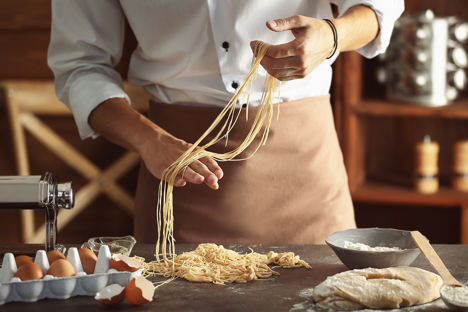
Maccheroncini di Campofilone: Le Marche’s six hundred year old pasta
Le Marche is a region of many gastronomic delights, but chief among them is maccheroncini di Campofilone – a rich, silky egg pasta that has been produced in the region for six hundred years and counting.
Maccheroncini di Campofilone: Le Marche’s six hundred year old pasta
Le Marche is a region of many gastronomic delights, but chief among them is maccheroncini di Campofilone – a rich, silky egg pasta that has been produced in the region for six hundred years and counting.
As we travel and read our way around Italy, one thing that always strikes us is the beauty of the country’s regional nuances. Pasta is a fantastic example – we often think of pasta in simple ‘Italian’ terms, but it varies hugely from region to region. In the south, pasta is a simple mixture of flour and water, but travel north into Le Marche and it’s a very different story – there’s no water in the pasta here, just eggs and lots of them. If you’re in the area, you’ll see maccheroncini di Campofilone everywhere – these are one of Le Marche’s prized gastronomic treasures, a traditional egg pasta that dates back to the early 1400s.
Trace back to the origins of most Italian foods and you’ll often find they have their roots in the kitchens of the poor – maccheroncini di Campofilone is no exception. Food wasn’t always abundant in the fifteenth and sixteenth centuries, and egg pasta became a staple of the region. By drying their pasta dough in ultra-thin strands, the people of Campofilone discovered a way to preserve egg pasta so it could be eaten all year round. In this way, maccheroncini di Campofilone was born out of necessity, but it quickly became hugely popular in Le Marche and beyond.
Today’s maccheroncini di Campofilone is made the exact same way it has always been – the dough is made with a hefty ten eggs to every kilo of flour, before being rolled super-thin to around half a millimetre, cut to a thickness of around a millimetre and then dried on sheets of paper. It’s a process that has been handed down from generation to generation in Campofilone, and in 2013, maccheroncini di Campofilone became the first pasta to become IGP-protected in Italy, officially recognising the pasta’s significance and tying it forever to the village of its origin.
The name can be a little confusing if you’re somewhat versed in Italian – anywhere else in Italy, maccheroncini would indicate a short, hollow pasta but in Le Marche, maccheroncini di Campofilone is more like what we think of as capelli d’angelo or angel hair. Originally this would have been simply to help the pasta dry in the sun and prevent it from breaking during cooking, but that paper-thinness is also what gives maccheroncini di Campofilone its incredible melt in the mouth texture, as well as maximum surface area for grabbing onto that precious pasta sauce.
Although maccheroncini is the most traditional shape, but today’s artisans make pasta di Campofilone in all sorts of different shapes and sizes, from linguine and pappardelle to little gnocchetti. Still, if you want a true taste of Le Marche, keep an eye out for the original maccheroncini served with a creamy sauce of chicken giblets, or with a rich meat or seafood ragu. Or, why not try making some yourself? Just don’t skimp on the eggs.


